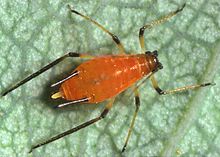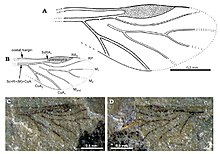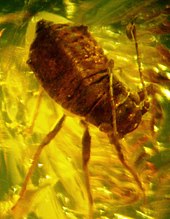Aphidoidea — разлика између измена
. |
(нема разлике)
|
Верзија на датум 11. новембар 2019. у 23:11
| Afidi Vremenski raspon: Perm - sadašnjost
| |
|---|---|

| |
| Naučna klasifikacija | |
| Domen: | Eukaryota |
| Carstvo: | Animalia |
| Tip: | Arthropoda |
| Klasa: | Insecta |
| Red: | Hemiptera |
| Podred: | Sternorrhyncha |
| Infrared: | Aphidomorpha |
| Natporodica: | Aphidoidea Geoffroy, 1762 |
| Familije | |
| |
Један корисник управо ради на овом чланку. Молимо остале кориснике да му допусте да заврши са радом. Ако имате коментаре и питања у вези са чланком, користите страницу за разговор.
Хвала на стрпљењу. Када радови буду завршени, овај шаблон ће бити уклоњен. Напомене
|
Afidi su mali insekti koji sišu biljni sok. Oni su članovi nadfamilije Aphidoidea. Common names include greenfly and blackfly,[а] although individuals within a species can vary widely in colour. The group includes the fluffy white woolly aphids. A typical life cycle involves flightless females giving living birth to female nymphs without the involvement of males. Maturing rapidly, females breed profusely so that the number of these insects multiplies quickly. Winged females may develop later in the season, allowing the insects to colonise new plants. In temperate regions, a phase of sexual reproduction occurs in the autumn, with the insects often overwintering as eggs.
The life cycle of some species involves an alternation between two species of host plants, for example between an annual crop and a woody plant. Some species feed on only one type of plant, while others are generalists, colonising many plant groups. About 5,000 species of aphid have been described, all included in the family Aphididae. Around 400 of these are found on food and fibre crops, and many are serious pests of agriculture and forestry, as well as an annoyance for gardeners. So-called dairying ants have a mutualistic relationship with aphids, tending them for their honeydew, and protecting them from predators.
Aphids are among the most destructive insect pests on cultivated plants in temperate regions. In addition to weakening the plant by sucking sap, they act as vectors for plant viruses and disfigure ornamental plants with deposits of honeydew and the subsequent growth of sooty moulds. Because of their ability to rapidly increase in numbers by asexual reproduction, they are a highly successful group of organisms from an ecological standpoint.[1]
Distribucija
Afidi su distributed worldwide, but are most common in temperate zones. In contrast to many taxa, aphid species diversity is much lower in the tropics than in the temperate zones.[2] They can migrate great distances, mainly through passive dispersal by winds. Winged aphids may also rise up in the day as high as 600 m where they are transported by strong winds.[3][4] For example, the currant-lettuce aphid, Nasonovia ribisnigri, is believed to have spread from New Zealand to Tasmania around 2004 through easterly winds.[5] Aphids have also been spread by human transportation of infested plant materials, making some species nearly cosmopolitan in their distribution.[6]
Evolution


Fosilna istorija
Afidi, i blisko srodni adelgidi i filokserani, probably evolved from a common ancestor some 280 милиона година, in the Early Permian period.[8] They probably fed on plants like Cordaitales or Cycadophyta. With their soft bodies, aphids do not fossilize well, and the oldest known fossil is of the species Triassoaphis cubitus from the Triassic.[9] They do however sometimes get stuck in plant exudates which solidify into amber. In 1967, when Professor Ole Heie wrote his monograph Studies on Fossil Aphids, about sixty species have been described from the Triassic, Jurassic, Cretaceous and mostly the Tertiary periods, with Baltic amber contributing another forty species.[10] The total number of species was small, but increased considerably with the appearance of the angiosperms 160 милиона година, as this allowed aphids to specialise, the speciation of aphids going hand-in-hand with the diversification of flowering plants. The earliest aphids were probably polyphagous, with monophagy developing later.[11] It has been hypothesized that the ancestors of the Adelgidae lived on conifers while those of the Aphididae fed on the sap of Podocarpaceae or Araucariaceae that survived extinctions in the late Cretaceous. Organs like the cornicles did not appear until the Cretaceous period.[8][12] One study alternatively suggests that ancestral aphids may have lived on angiosperm bark and that feeding on leaves may be a derived trait. The Lachninae have long mouth parts that are suitable for living on bark and it has been suggested that the mid-Cretaceous ancestor fed on the bark of angiosperm trees, switching to leaves of conifer hosts in the late Cretaceous.[13] The Phylloxeridae may well be the oldest family still extant, but their fossil record is limited to the Lower Miocene Palaeophylloxera.[14]
Taksonomija
Late 20th-century reclassification within the Hemiptera reduced the old taxon "Homoptera" to two suborders: Sternorrhyncha (aphids, whiteflies, scales, psyllids, etc.) and Auchenorrhyncha (cicadas, leafhoppers, treehoppers, planthoppers, etc.) with the suborder Heteroptera containing a large group of insects known as the true bugs. The infraorder Aphidomorpha within the Sternorrhyncha varies with circumscription with several fossil groups being especially difficult to place but includes the Adelgoidea, the Aphidoidea and the Phylloxeroidea.[15] Some authors use a single superfamily Aphidoidea within which the Phylloxeridae and Adelgidae are also included while others have Aphidoidea with a sister superfamily Phylloxeroidea within which the Adelgidae and Phylloxeridae are placed.[16] Early 21st-century reclassifications substantially rearranged the families within Aphidoidea: some old families were reduced to subfamily rank (e.g., Eriosomatidae), and many old subfamilies were elevated to family rank. The most recent authoritative classifications have three superfamilies Adelgoidea, Phylloxeroidea and Aphidoidea. The Aphidoidea includes a single large family Aphididae that includes all the ~5000[2] extant species.[17]
Filogenija
Spoljna
Afidi, adelgidi, i filokseridi su veoma blisko srodni, and are all within the suborder Sternorrhyncha, the plant-sucking bugs. They are either placed in the insect superfamily Aphidoidea[18] or into the superfamily Phylloxeroidea which contains the family Adelgidae and the family Phylloxeridae.[11][19] Like aphids, phylloxera feed on the roots, leaves, and shoots of grape plants, but unlike aphids, do not produce honeydew or cornicle secretions.[20] Phylloxera (Daktulosphaira vitifoliae) are insects which caused the Great French Wine Blight that devastated European viticulture in the 19th century. Similarly, adelgids or woolly conifer aphids, also feed on plant phloem and are sometimes described as aphids, but are more properly classified as aphid-like insects, because they have no cauda or cornicles.[21]
Napomene
- ^ The term "black fly" is also used for the Simuliidae, among them the vector of river blindness.
Reference
- ^ Piper, Ross (2007). Extraordinary Animals: An Encyclopedia of Curious and Unusual Animals. Greenwood Press. стр. 6—9. ISBN 978-0-313-33922-6.
- ^ а б Żyła, Dagmara; Homan, Agnieszka; Wegierek, Piotr (2017). „Polyphyly of the extinct family Oviparosiphidae and its implications for inferring aphid evolution (Hemiptera, Sternorrhyncha)”. PLOS ONE. 12 (4): e0174791. Bibcode:2017PLoSO..1274791Z. PMC 5405925
 . PMID 28445493. doi:10.1371/journal.pone.0174791.
. PMID 28445493. doi:10.1371/journal.pone.0174791.
- ^ Berry, R. E.; Taylor, L. R. (1968). „High-Altitude Migration of Aphids in Maritime and Continental Climates”. Journal of Animal Ecology. 37 (3): 713—722. JSTOR 3084. doi:10.2307/3084.
- ^ Isard, Scott A.; Irwin, Michael E.; Hollinger, Steven E. (1990-10-01). „Vertical Distribution of Aphids (Homoptera: Aphididae) in the Planetary Boundary Layer”. Environmental Entomology. 19 (5): 1473—1484. doi:10.1093/ee/19.5.1473.
- ^ Hill, L. (2012). „The currant lettuce aphid, Nasonovia ribisnigri arrives in Tasmania: Part 1”. Victorian Entomologist. 42 (2): 29—31.
- ^ Margaritopoulos, John T.; Kasprowicz, Louise; Malloch, Gaynor L.; Fenton, Brian (2009-05-11). „Tracking the global dispersal of a cosmopolitan insect pest, the peach potato aphid”. BMC Ecology. 9: 13. PMC 2687420
 . PMID 19432979. doi:10.1186/1472-6785-9-13.
. PMID 19432979. doi:10.1186/1472-6785-9-13.
- ^ Szwedo, J.; Nel, A. 2011. The oldest aphid insect from the Middle Triassic of the Vosges, France. Acta Palaeontologica Polonica 56 (4): 757–766
- ^ а б Capinera, John L. (2008). Encyclopedia of Entomology. Springer Science & Business Media. стр. 193—194. ISBN 978-1-4020-6242-1.
- ^ Johnson, Christine; Agosti, Donat; Delabie, Jocques H.; Dumpert, Klaus; Williams, D. J.; von Tschirnhaus, Michael; Macshwitz, Ulrich (2001). „Acropyga and Azteca ants (Hymenoptera: Formicidae) with scale insects (Sternorrhyncha: Coccoidea): 20 million years of intimate symbiosis” (PDF). American Museum Novitates. 3335: 1—18. doi:10.1206/0003-0082(2001)335<0001:AAAAHF>2.0.CO;2.
- ^ Russell, Louise M. (1968). „Studies on Fossil Aphids” (PDF). Bulletin of the Entomological Society of America. 14 (2): 139—140. doi:10.1093/besa/14.2.139a.
- ^ а б Dixon, A. F. G. (1998). Aphid Ecology (2nd изд.). Chapman and Hall. ISBN 978-0-412-74180-7.
- ^ Von Dohlen, Carol D.; Moran, Nancy A. (2000). „Molecular data support a rapid radiation of aphids in the Cretaceous and multiple origins of host alternation”. Biological Journal of the Linnean Society. 71 (4): 689—717. doi:10.1111/j.1095-8312.2000.tb01286.x.
- ^ Chen, Rui; Favret, Colin; Jiang, Liyun; Wang, Zhe; Qiao, Gexia (29. 9. 2015). „An aphid lineage maintains a bark-feeding niche while switching to and diversifying on conifers”. Cladistics. 32 (5): 555—572. doi:10.1111/cla.12141.
- ^ Gullan, Penny J.; Martin, Jon H. (2009). „Sternorrhyncha”. Encyclopedia of Insects (2nd изд.).
- ^ Rohdendorf, B. B., ур. (1991). Fundamentals of Paleontology. Volume 9. Arthropoda, Tracheata, Chelicerata. Smithsonian Institution and National Science Foundation. стр. 267—274.
- ^ Sorensen, J. T. (2009). „Aphids”. Ур.: Resh, Vincent H.; Cardé, R. T. Encyclopedia of Insects (2 изд.). Academic Press. стр. 27—31.
- ^ „Superfamily Aphidoidea, Latreille, 1802”. Aphid: species file. Приступљено 3. 2. 2018.
- ^ Blackman, R. L.; Eastrop, V. F. (1994). Aphids on the World's Trees. An Identification and Information Guide. Wallingford: CAB International. ISBN 978-0-85198-877-1.
- ^ Mutti, Navdeep S. (2006). Molecular Studies of the Salivary Glands of the Pea Aphid, Acyrthosiphon pisum (Harris) (PDF) (Теза). Kansas State University.
- ^ Granett, Jeffrey; Walker, M. Andrew; Kocsis, Laszlo; Omer, Amir D. (2001). „Biology and management of grape phylloxera”. Annual Review of Entomology. 46: 387—412. doi:10.1146/annurev.ento.46.1.387.
- ^ McGavin, George C. (1993). Bugs of the World. Infobase Publishing. ISBN 978-0-8160-2737-8.
Spoljašnje veze
- Aphids of southeastern U.S. woody ornamentals
- Acyrthosiphon pisum, MetaPathogen – facts, life cycle, life cycle image
- Sequenced Genome of Pea Aphid, Agricultural Research Service
- Insect Olfaction of Plant Odour: Colorado Potato Beetle and Aphid Studies
- Asian woolly hackberry aphid, Center for Invasive Species Research
- Aphis gossypii, melon or cotton aphid
- Aphis nerii, oleander aphid
- Hyadaphis coriandri, coriander aphid
- Longistigma caryae, giant bark aphid
- Myzus persicae, green peach aphid
- Sarucallis kahawaluokalani, crapemyrtle aphid
- Shivaphis celti, an Asian woolly hackberry aphid
- Toxoptera citricida, brown citrus aphid
